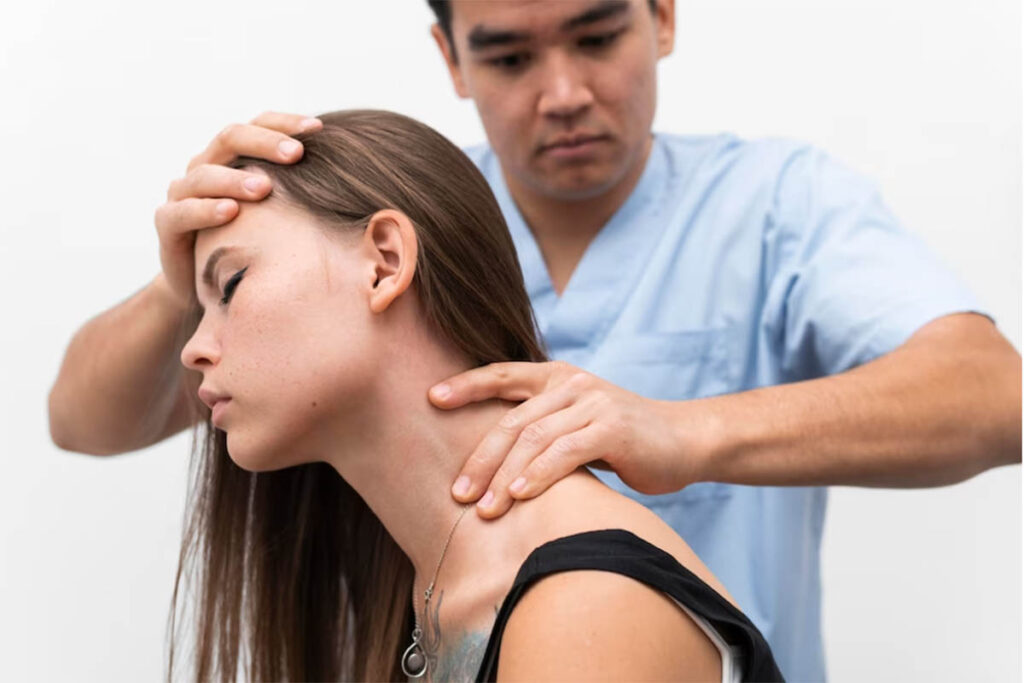Back pain is a prevalent and often debilitating issue that can affect people of all ages and backgrounds. Whether you’re a student hunched over textbooks, a professional spending hours at a desk, an athlete pushing your limits, or a senior dealing with age-related changes, understanding the causes, prevention, and management of back pain is crucial for maintaining a pain-free and active life. In this comprehensive article, we will explore the various aspects of back pain, including its causes, types, diagnosis, treatment options, and preventive measures. Whether you’re a healthcare professional or someone experiencing back pain, this guide will provide valuable insights into this common condition.
Table of Contents
- Introduction
- Anatomy of the Back
- Types and Causes of Back Pain
- a. Muscular Causes
- b. Joint-Related Causes
- c. Nerve-Related Causes
- d. Mechanical Causes
- Diagnosing Back Pain
- a. Medical History and Physical Examination
- b. Imaging Studies
- c. Laboratory Tests
- d. Specialized Tests
- Treatment Options for Back Pain
- a. Conservative Approaches
- b. Medications
- c. Physical Therapy
- d. Injections
- e. Surgical Interventions
- Preventing Back Pain
- a. Proper Posture and Ergonomics
- b. Exercise and Core Strengthening
- c. Weight Management
- d. Proper Lifting Techniques
- e. Stress Management
- Living with Back Pain
- a. Coping Strategies
- b. Assistive Devices
- c. Emotional Well-being
- Conclusion
1. Introduction
Back pain is a common ailment that can significantly affect your daily life, making even simple tasks challenging. Whether it’s acute or chronic, understanding the root causes and effective management strategies is essential for regaining comfort and functionality. In this article, we will delve into the complexities of back pain, exploring its various causes, diagnostic methods, treatment options, and preventive measures.
2. Anatomy of the Back

Before delving into the intricacies of back pain, it’s essential to understand the basic anatomy of the back:
- Spinal Column: The backbone or spinal column consists of 33 vertebrae that provide structural support and protect the spinal cord.
- Muscles and Ligaments: Muscles and ligaments surround the spine, providing support, flexibility, and stability. These include the erector spinae, latissimus dorsi, and the many ligaments that hold the vertebrae together.
- Nerves: The spinal cord and peripheral nerves transmit signals for movement and sensation throughout the body.
3. Types and Causes of Back Pain
Back pain can have various causes, and understanding its origin is essential for effective management. Let’s explore some common types and causes:
a. Muscular Causes
- Muscle Strains: Overstretching or tearing of muscles and ligaments can lead to acute back pain. This often happens due to improper lifting, sudden movements, or overuse.
- Muscle Imbalances: Weakness or imbalances in the muscles supporting the spine can lead to poor posture and chronic pain.
b. Joint-Related Causes
- Osteoarthritis: The degeneration of cartilage in the joints of the spine can result in pain, stiffness, and decreased mobility.
- Facet Joint Dysfunction: Dysfunction or degeneration of the facet joints in the spine can cause localized pain and restricted movement.
c. Nerve-Related Causes
- Sciatica: Compression or irritation of the sciatic nerve can result in radiating pain down the leg, often originating from the lower back.
- Spinal Stenosis: Narrowing of the spinal canal can put pressure on the spinal cord and nerves, leading to pain and numbness.
d. Mechanical Causes
- Herniated Disc: When the soft, gel-like center of an intervertebral disc protrudes, it can press on spinal nerves, causing pain and numbness.
- Spondylolisthesis: This condition occurs when one vertebra slips forward over the one beneath it, potentially causing pain and nerve compression.
4. Diagnosing Back Pain
Accurate diagnosis is crucial for effective treatment. Healthcare providers use various methods to diagnose the underlying cause of back pain:
a. Medical History and Physical Examination
Your healthcare provider will start by taking a detailed medical history and conducting a physical examination to assess your symptoms, range of motion, and spine stability.
b. Imaging Studies
Imaging tests such as X-rays, MRI scans, and CT scans can provide detailed images of the spine and surrounding structures, helping to identify structural abnormalities, fractures, or degenerative changes.
c. Laboratory Tests
Blood tests may be performed to check for markers of inflammation, infection, or underlying medical conditions like arthritis or infection.
d. Specialized Tests
In some cases, specialized tests such as electromyography (EMG) or nerve conduction studies may be required to assess specific nerve-related issues.
5. Treatment Options for Back Pain

The treatment approach for back pain depends on the underlying cause and severity of the condition. Here are some common treatment options:
a. Conservative Approaches
- Rest and Activity Modification: Resting the affected area and avoiding activities that worsen pain can facilitate healing.
- Physical Therapy: Physical therapists can develop customized exercise programs to strengthen muscles, improve flexibility, and correct movement patterns.
- Bracing: Using back braces or supports can provide stability and alleviate pain.
b. Medications
- Pain Relievers: Over-the-counter pain relievers like acetaminophen or nonsteroidal anti-inflammatory drugs (NSAIDs) can help manage pain and reduce inflammation.
- Prescription Medications: Stronger pain medications or muscle relaxants may be prescribed for severe pain.
c. Physical Therapy
Physical therapy is a cornerstone of back pain management. Therapists can employ various techniques, including:
- Strengthening Exercises: Targeting specific muscle groups to improve spine stability and function.
- Manual Therapy: Hands-on techniques to improve joint mobility and reduce pain.
- Modalities: Such as heat, ice, ultrasound, or electrical stimulation to alleviate pain and inflammation.
d. Injections
- Corticosteroid Injections: These can provide temporary relief from pain and inflammation, often used for conditions like sciatica or facet joint dysfunction.
- Epidural Injections: Injecting medication into the space around the spinal cord can help reduce inflammation and alleviate pain for certain conditions like herniated discs.
e. Surgical Interventions
In severe cases where conservative treatments are ineffective or for specific structural issues, surgical options may be considered. These may include procedures to repair herniated discs, stabilize the spine, or address structural abnormalities.
6. Preventing Back Pain
Prevention is crucial for maintaining a healthy back. Here are some preventive strategies:
a. Proper Posture and Ergonomics
- Maintain good posture during activities like sitting, standing, and lifting to reduce strain on the back.
- Ensure your workstation and daily activities are ergonomically designed to minimize stress on the spine.
b. Exercise and Core Strengthening
- Engage in regular physical activity to strengthen the core and back muscles.
- Perform specific exercises targeting the muscles that support the spine.
c. Weight Management
Maintaining a healthy weight can reduce the load on the spine, decreasing the risk of back pain and related issues.
d. Proper Lifting Techniques
Use proper body mechanics and lifting techniques to avoid strain on the back when lifting heavy objects.
e. Stress Management
Practice stress-reduction techniques like meditation or yoga, as stress can exacerbate muscle tension and pain.
7. Living with Back Pain
For some individuals, back pain may become a chronic condition. Coping strategies, assistive devices, and addressing emotional well-being are essential aspects of living with ongoing pain:
a. Coping Strategies
- Learn pain management techniques, such as relaxation exercises and mindfulness, to help cope with chronic pain.
- Consider seeking support from a pain management specialist or therapist to develop effective pain coping strategies.
b. Assistive Devices
- Use ergonomic tools and assistive devices to reduce strain on the back during daily activities.
- Consider devices like back braces or lumbar supports for additional stability and comfort.
c. Emotional Well-being
- Address the psychological aspects of chronic pain through counseling or support groups, as chronic pain can have a significant impact on emotional well-being.
8. Conclusion
Back pain is a common condition that can significantly impact your quality of life. Whether you’re experiencing acute discomfort or dealing with chronic pain, understanding its causes, seeking appropriate medical care, and implementing preventive measures are key to maintaining a healthy and pain-free back. If you experience persistent or severe back pain, consult a healthcare professional for a thorough evaluation and personalized treatment plan. Early intervention, comprehensive care, and a commitment to prevention can lead to better outcomes and an improved quality of life.



